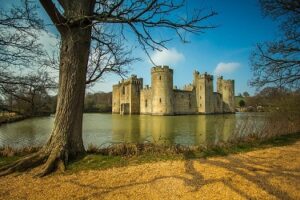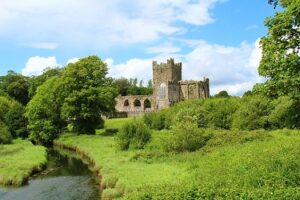Table of Contents
Was the Sussex carol written in Sussex, and the Wexford carol in Wexford?
With this question we are plunged back in to the delightful, charming, and sometimes weird world of traditional Christmas carols, and indeed of folk music in general. Since true folk music, and not someone’s attempt to write something that sounds like folk music, is passed down orally before being written, it’s always pretty much impossible to find the original version, if indeed there is such a thing.

On Christmas Night
So, let’s start with the so-called “Sussex Carol,” also often titled by the words of the first line, “On Christmas Night.” The words were first published (not written) in the 1600’s by an Irish bishop. But wait a minute! Sussex isn’t in Ireland; it’s in southeast England. Why isn’t it called The Dublin Carol, or the Galway Carol, or even (just to confuse things) the Wexford Carol, since Wexford is in Ireland? The answer is that Sussex was where the tune (not the words) was first written down. by none other than Ralph Vaughn Williams, who went around the English countryside in the early 1900’s getting elderly people to sing folk songs to him so that he could record them. (And don’t pronounce his first name as “Ralph”! He hated being called “Ralph.” He considered the correct pronunciation to be Rafe.) This activity was much like what was done under the auspices of the Library of Congress here in the US. So the only reason why we call it the Sussex carol is that Williams heard the tune from someone named Harriet Verrall of Monk’s Gate, near Horsham, Sussex. (You can see where the town is on Google maps; it looks pretty tiny. I’m sure there’s a story behind its name, probably lost to history.) Don’t these bare facts conjure up a whole narrative? Here’s the young Williams in the hamlet of Monk’s Gate, being directed to the home of Mrs. Verrall who, he’s been told, knows a lot of old folk songs. She’s sitting in a rocking chair with a blanket over her arthritic knees, and her cloudy blue eyes gaze into nothingness as she sings in her quavery voice . . . . Well, it could have happened like that, and maybe it did! Whatever the specific situation, Williams liked the carol he heard from her so much that he used it in his 1912 “Fantasia on Christmas Carols” and in his collection called “Eight Traditional Christmas Carols.” You are most likely to be familiar with this carol from its inclusion in the King’s College “Festival of Nine Lessons and Carols.”

Good People All
So much for our carol from Sussex. On to Wexford, both the place and the song, since the two match up in this case. Also known by its first line, “Good People All, this Christmas Time,” it seems to be quite ancient, with some sources saying that the original dates back to the 12th century and is one of the the oldest extant carols that we have. But it wasn’t published until 1928 when it was included in the Oxford Book of Carols. The music director from a cathedral in Wexford transcribed it from “a local singer,” but here no name is given for that person. So what we have today is an early 20th-century version that someone sang to a professional musician, who wrote it down and made who knows what changes, managing to get it into a prestigious publication. There is a Gaelic version as well as an English one, so I guess that’s what this “local singer” actually sang. I’m afraid my Gaelic is pretty rusty, so I don’t know how closely the English version follows it. Anyway, one bit of irony about the traditions connected with this carol is that originally only men were allowed to sing it, but one of its most famous performances is by Julie Andrews. I’ve posted the video below.
Both of these carols strongly emphasize the purpose of Christ’s coming to earth and not the holiday itself. So there’s no mention of feasting, or gift-giving, or dancing. Instead, both carols clearly spell out the bigger implications of the Christmas story. The sacrificial aspect is noted in the line, “What our good God for us has done/In sending his beloved Son.” Salvation for mankind is emphasized repeatedly: “Oh why should men on earth be sad/When our Redeemer made us glad,“ “When from our sins he set us free/All for to gain our liberty,” and “All out of darkness we have light.”
The Bitter Withy
But not all traditional carols are quite so traditional in doctrine. I have to stop here and pontificate a bit on the absolute weirdest folk carol I’ve run across so far in my research, “The Bitter Withy,” although technically it’s not a Christmas carol per se since it’s about Jesus’ childhood, not His birth, but it’s included in some old carol collections. It could almost be classified as blasphemous, since it involves a prank that the child Jesus purportedly pulls on some uppity young noblemen, a prank with fatal consequences. But the song, silly and offensive as it may be, has some very interesting theological ideas hidden within it. So, the story goes, one rainy day the child Jesus asks Mary if he can go outside and play ball. He runs out and meets up with three noble children. “Will you play ball with me?” he asks. “Not hardly,” they say, sniffily. “We are highborn, but you are a maiden’s child, of lowly birth.” (Note that they call Jesus “a maiden’s child,” or in some versions “a poor maid’s child,” implying that he doesn’t have a legitimate father.) So Jesus gets mad and says that he’ll show them that he is above them all:
Now our savior built a bridge with the beams of the sun
and over the water ran he, ran he
And the three jolly children followed after him
And drowned they were all three.
The mothers of the three dead children come crying to Mary to tell her what Jesus has done, and Mary promptly picks a handful of “withies,” or willow twigs, and gives Jesus “slashes three.” (If you’re of a certain age, you may remember the practice of children being spanked with a “switch,” and even being told to go cut the switch that’s going to be used to spank them.) Jesus curses the “bitter withy,” the willow that has given Mary her weapon, saying that it “shall be the very first tree that shall perish right at the heart.” So one point of this legend is that it explains why the willow tree rots from the inside rather than the outside. (Is that really true? Any arborists reading this post may reply.) The idea of Jesus walking on water is neatly included also. But there’s a lot more going on here, because there were serious theological discussions about the nature of Christ on earth: Was he truly God and truly man, both at the same time? If he had a human nature, could that human nature sin? Did he ever misbehave as a child and need discipline? At some point these questions made their way into this song, and we know it’s a true folk song because there are many versions of it. So some folk carols from Sussex or Wexford or wherever tell the Christmas story straightforwardly, and others such as “The Bitter Withy” remind us that there were all sorts of extra-Biblical ideas that became traditional legends as time went on. (At some point in this material I want to write about another truly strange one, “The Cherry Tree Carol.” But we’ll leave that for later.) It’s good to be reminded that Christmas carols aren’t just pretty songs; they include concepts that people have thought worthy of discussion, argument, and even persecution. Understanding those ideas cannot help but enrich the experience of the performers and the audience.
Here’s a lovely arrangement of the Sussex Carol by an up-and-coming young composer/arranger Elaine Hagenberg:
Here’s the promised Julie Andrews video of her singing the Wexford Carol:
And just for fun, a version of “The Bitter Withy”:
And here are the full lyrics of both carols:
The Sussex Carol:
On Christmas night all Christians sing
to hear the news the angels bring;
on Christmas night all Christians sing
to hear the news the angels bring:
news of great joy, news of great mirth,
news of our merciful King’s birth.
Then why should we on earth be sad,
since our Redeemer made us glad?
Then why should we on earth be sad,
since our Redeemer made us glad,
when from our sin He set us free,
all for to gain our liberty?
When sin departs before His grace,
then life and health come in its place;
when sin departs before His grace,
then life and health come in its place;
angels and men with joy may sing,
all for to see the newborn King.
All out of darkness we have light,
which made the angels sing this night;
all out of darkness we have light,
which made the angels sing this night:
“Glory to God and peace to men
now and forevermore. Amen.”
The Wexford Carol:
Good people all, this Christmas time,
Consider well and bear in mind
What our good God for us has done,
In sending His belovèd Son.
With Mary holy we should pray
To God with love this Christmas Day;
In Bethlehem upon the morn
There was a blest Messiah born.
The night before that happy tide
The noble virgin and her guide
Were long time seeking up and down
To find a lodging in the town.
But mark how all things came to pass:
From every door repelled, alas!
As long foretold, their refuge all
Was but a humble oxen stall.
Near Bethlehem did shepherds keep
Their flocks of lambs and feeding sheep;
To whom God’s angels did appear
Which put the shepherds in great fear.
Prepare and go, the angels said,
To Bethlehem, be not afraid;
For there you’ll find, this happy morn,
A princely babe, sweet Jesus born.
With thankful heart and joyful mind,
The shepherds went the babe to find,
And as God’s angel has foretold,
They did our Savior Christ behold.
Within a manger He was laid,
And by His side the virgin maid
Attending to the Lord of Life,
Who came on earth to end all strife.
©Debi Simons

